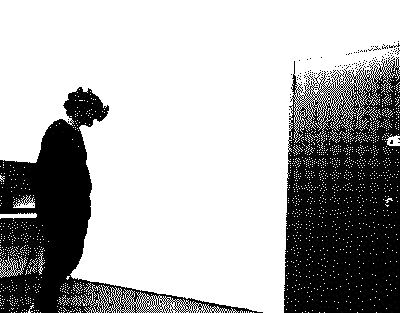Virtual Non-Reality
Words, Non-fiction
2017—06 (10)
Los Angeles, CA
Los Angeles, CA

Back in New York, I had the opportunity to experience VR for the first time, and I must admit, I was a little underwhelmed. Not by the applications VR is being used for, mind you, but by the shortcomings of the technology itself. This may have something to do with the fact that up to that point, everything I knew about VR was based entirely on what has been written about it, which to a large extent has been little more than a great deal of hype, and I’m afraid no art-form can truly develop by means of just hype without a fair share of objective criticism. And to that end, I’d like to touch upon where I feel this infant technology –as it stands today– is lacking, and thus might be improved upon.
1. Absence of peripheral
The way the goggles are designed does not allow for any peripheral vision. Your view is completely narrowed down and boxed in. Sure, you can see the world around you by turning your head left and right and looking up and down, but that isn’t how we experience the 3-dimensionality of reality. Just that absence of the peripheral alone is enough to keep one from feeling actually immersed inside that virtual space presented within the goggles. It is my understanding that there are a couple of goggles out there now that allow for a more widescreen 180 degree scope, but that would still be too limited, because in reality, even when we are looking straight ahead, not only are we aware of our surroundings to the left and right of the corners of our eyes, but we are equally aware of the ground beneath our feet and the sky above our heads. The only “goggle” that may be capable of recreating anything remotely close to a virtual reality would have to be in the form of a half sphere within which one inserts the entirety of their face. The inside of this half-sphere being the screen.
![]()
2. Looking into the light
What we see of the world we live in is the light deflected off the objects and things comprising it. We do not look into the light. We cannot look into the light. This has changed a little in recent years with computer screens and smartphones and LED TVs, not without a considerable amount of diffusion to the light sources, but even then, these sources of light only occupy a very limited part of our scope of vision, with much of our peripheral view being the world around these objects, seen in accordance to the light deflected off it. When we put on these VR goggles, we are placed in a world made up entirely of light, and it is most uncomfortable. Until they can figure out a way to make what we see inside those goggles a deflection of light rather than light itself (i.e. a projection), I don’t think it’ll really work.
![]()
![]()
3. CGI
CGI has nothing to do with reality, virtual or otherwise. There’s a popular hypothesis in aesthetics called the Uncanny Valley, which stipulates that human replicas which appear almost, but not exactly, like human beings elicit feelings of eeriness and revulsion. Because the rendering technology isn’t quite there, the materiality of everything within these VR worlds seems to be made out of plastic, metal, or rubber, but actually still not quite, and so you have an immediate disconnect forbidding any kind of actual immersion. Which, of course, defeats the purpose. And since reality cannot be achieved, I recommend steering as far away from it as possible, and instead constructing 3-dimensional worlds that do not in any way attempt to replicate the materiality of the real world, but are rather honest about what they are actually made of: light.
![]()
Having said that, my mind is buzzing with ideas about what might be done with the technology as it is right now. Something I might explore more seriously in the future.
1. Absence of peripheral
The way the goggles are designed does not allow for any peripheral vision. Your view is completely narrowed down and boxed in. Sure, you can see the world around you by turning your head left and right and looking up and down, but that isn’t how we experience the 3-dimensionality of reality. Just that absence of the peripheral alone is enough to keep one from feeling actually immersed inside that virtual space presented within the goggles. It is my understanding that there are a couple of goggles out there now that allow for a more widescreen 180 degree scope, but that would still be too limited, because in reality, even when we are looking straight ahead, not only are we aware of our surroundings to the left and right of the corners of our eyes, but we are equally aware of the ground beneath our feet and the sky above our heads. The only “goggle” that may be capable of recreating anything remotely close to a virtual reality would have to be in the form of a half sphere within which one inserts the entirety of their face. The inside of this half-sphere being the screen.

2. Looking into the light
What we see of the world we live in is the light deflected off the objects and things comprising it. We do not look into the light. We cannot look into the light. This has changed a little in recent years with computer screens and smartphones and LED TVs, not without a considerable amount of diffusion to the light sources, but even then, these sources of light only occupy a very limited part of our scope of vision, with much of our peripheral view being the world around these objects, seen in accordance to the light deflected off it. When we put on these VR goggles, we are placed in a world made up entirely of light, and it is most uncomfortable. Until they can figure out a way to make what we see inside those goggles a deflection of light rather than light itself (i.e. a projection), I don’t think it’ll really work.


3. CGI
CGI has nothing to do with reality, virtual or otherwise. There’s a popular hypothesis in aesthetics called the Uncanny Valley, which stipulates that human replicas which appear almost, but not exactly, like human beings elicit feelings of eeriness and revulsion. Because the rendering technology isn’t quite there, the materiality of everything within these VR worlds seems to be made out of plastic, metal, or rubber, but actually still not quite, and so you have an immediate disconnect forbidding any kind of actual immersion. Which, of course, defeats the purpose. And since reality cannot be achieved, I recommend steering as far away from it as possible, and instead constructing 3-dimensional worlds that do not in any way attempt to replicate the materiality of the real world, but are rather honest about what they are actually made of: light.

Having said that, my mind is buzzing with ideas about what might be done with the technology as it is right now. Something I might explore more seriously in the future.
